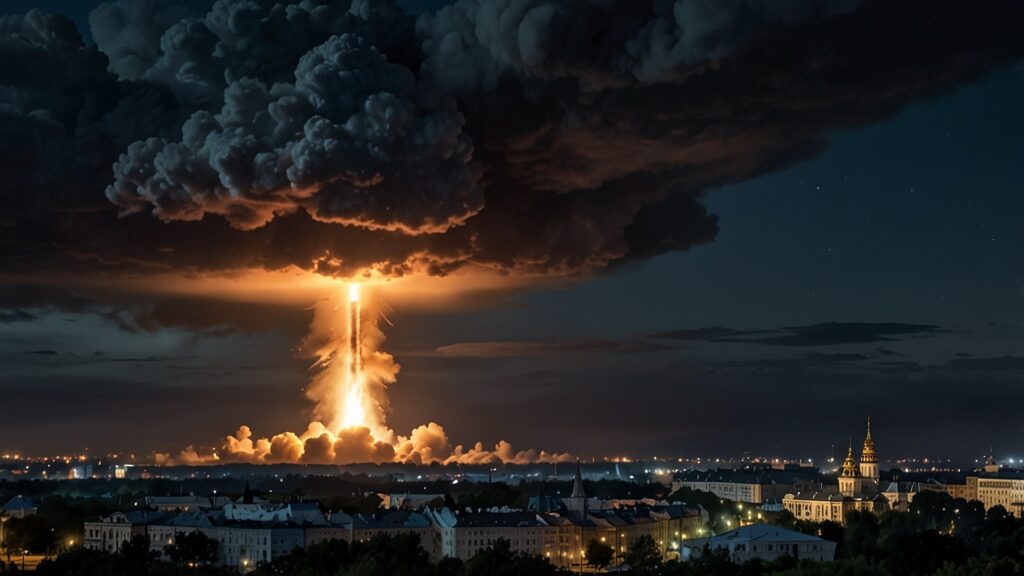
In a theatrical upsurge to the already going on Russia-Ukraine war, Russia has just declared that it intends to shoot a new intercontinental hypersonic missile over Ukrainian airspace within just a few minutes.
This scandalous action, disclosed in the form of a pro-Russian social media post has intensified the world situation and caused an apprehension of a new stage of the war.
The missile is capable of revolutionizing the warfare today with its unparalleled speed and distance and so extreme measures have been called to curb the further destabilization by employing diplomacy.
This is a breaking news, which came out at 4:50 PM IST on September 8, 2025, and it highlights the unstable stakes in Eastern Europe.
Russia’s Bold Missile Test Plan
The news, published through one of the social media outlets coordinated with Moscow, outlined the plan in which Russia would be testing an advanced intercontinental hypersonic missile, over Ukraine in a live event.
This weapon is said to have a speed of greater than Mach 5 and hit a target thousands of miles away, making it unstoppable by the best defence mechanism. That it has been decided to demonstrate it in an active war zone has left observers stunned both in terms of demonstrating the capabilities of Russian technology, but also as a vivid warning to Ukraine and its Western allies.
This is after a massive overnight raid by Russia into Ukraine that killed at least four and wounded 44 Ukraine citizens by the use of more than 150 drones and 13 missiles.
A significant number of projectiles were stopped by Ukrainian troops, but the magnitude of the bombardment underlines the aggressive stand of Moscow.
The hypersonic trial would seem to be in response to the recent advances of Ukraine in missile technology, in particular the Flamingo system that Ukraine boasts to hit deep into Russian airspace, increasing the technological arms race.
Hypersonic missiles are fast and maneuverable which can hardly be intercepted with the existing defenses. The current Russian arsenal of missiles, such as Kinzhal or Zircon, already has combat applications in Ukraine.
These could be advanced by the new missile which could be more precise or have a higher payload. A demonstration in Ukraine would give practical information and send a shiver to NATO and the U.S.
Russia’s Hypersonic Strategy and Global Power Play
Hypersonic technology has been in the pipeline in Russia to neutralize the Western missile defense systems. In August 2025, President Vladimir Putin confirmed the manufacturing of new hypersonic variants, and they are to be deployed in other allied countries such as Belarus.
This is in tandem with increased military readiness of Russia, comprising 2,500 missiles, 250 tanks and 1,100 armored vehicles, which is an indication of a long-term conflict or possible confrontations with NATO.
This fact is made worse with the decision of Moscow to remove restrictions to the use of intermediate-range missiles deployment after the failure of arms control agreements between the West and Moscow.
The hypersonic missile has an intercontinental range so in theory it can be used to attack far-off countries including the U.S, though its capability is yet to be confirmed. This test can also be taken as a reaction to the increasing drone and missile potential of Ukraine, which hit Russian territories and aroused the alarm of many people.
Impact on the Ukraine War
Carrying out a hypersonic missile experiment in Ukraine is gambling a lot. It would give Russia an opportunity to test the weapon on the conditions of a powerful war, electronic warfare, and air defense systems.
Nevertheless, it will trigger a more aggressive reaction of NATO, which may speed up the provision of arms to Ukraine. NATO has already convened emergency meeting due to such Russian activities restating its duty to Kyiv.
On a political front, the test conforms to the Putin style of deterrence through intimidation. Through the demonstration of new-fangled weaponry, Russia expects to deter the increase of the West, including Ukraine deploying long-range missiles on Russian territory, the U.S.
President Donald Trump has expressed his anger about the war, pushing the idea of imposing sanctions to undermine the Russian economy, but also questions the Ukrainian strategy.
Such announcement may complicate the diplomacy as this is a step towards the more dangerous stage of the conflict.
Both countries are economically strained. The emphasis of Russia on missile manufacturing consumes resources in other sectors, which are made worse by the western sanctions.
Ukraine is heavily investing in systems such as the Flamingo that will be able to cripple the infrastructure of Russia, which relies on foreign aid. The test might even dislocate the global markets especially energy since the region is significant in supply chains.
Global Reactions and Risks
Ukraine has denounced the intended test as an aggressive act and called on allies to increase air-defenses. In Russia, the announcement has roused nationalist pride and fears of Ukrainian retaliation, some of them threatening strikes against strategic targets, such as the Kerch Bridge.
This is considered a direct challenge to Western countries, especially U.S., which intends to have its own hypersonic weapons in 2027.
Countries in Europe close to Russia might be pressuring to have more NATO troops on the ground whereas the history of Belarusian President Alexander Lukashenko may indicate that there was internal discussions in Russia on whether to escalate it or not.
The test may trigger new appeals to halt the arms race around the world, since Russia and the U.S. have enormous nuclear arsenals totaling more than 5,000 warheads each. There is still the danger of miscalculation and there are analysts who have opined that the spiral to disastrous war is there.
This could be perceived by the allies of Russia in Asia and Latin America as a demonstration of great power, but the neutral countries might be vigilant to nuclear weapons advancement.
The implications of the test go much further than Ukraine and the test may redefine the world order in the field of security.
Pathways to Stability
With this crisis going on, it is salient that it be de-escalated. There should be diplomatic push, albeit strained. The U.S. might use its leverage to drive negotiations, and provide economic incentives to stop the escalation.
The technological development of Ukraine implies that it will be able to stand on its own and one of the Russian may be forced to negotiate. This is a technology flex/ geopolitical gambit test of the hypersonic missile.
The international community should strike promptly to curb the further development, such that military innovations are used as a means of peace and not war.
The skies of Ukraine continue to have the eyes of the world as the future of global stability is being tested.

